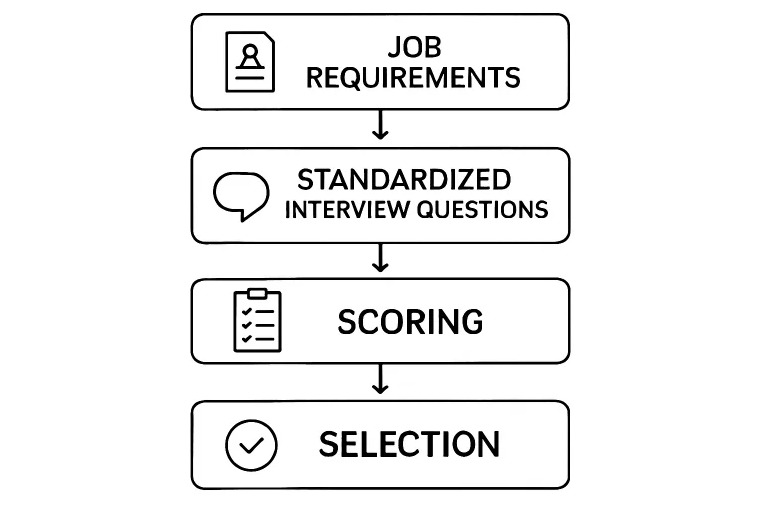Menu list
Introduction
In a rapidly changing business landscape, talent is more than a resource—it’s a critical differentiator that impacts growth, innovation, and overall organizational success. Today’s employers face fierce competition in finding and securing the right talent, making it essential to approach recruitment with precision and confidence. Structured interview process has emerged as a robust solution, offering a rigorous, objective, and fair approach to recruitment that optimizes outcomes for both companies and candidates. This methodology is about more than following a trend—it’s about transforming recruitment from a gut-driven process into a repeatable, well-calibrated journey guided by data and integrity.
By shifting away from intuition-based, inconsistent hiring habits and introducing well-defined, standardized workflows, structured hiring empowers organizations to make smart, equitable, and scalable hiring decisions. This not only dramatically increases the chances of securing top-tier talent but also fosters an environment of transparency and respect at every point of contact for job seekers. Let’s explore how adopting structured hiring practices can revolutionize your entire recruitment journey.
Defining Structured Hiring
Structured hiring refers to a deliberate, systematic approach to recruitment that eliminates ambiguity and subjective decision-making. Traditional hiring often leaves too much up to chance or individual bias, with interviewers asking improvised questions or interpreting resumes inconsistently. In contrast, a structured hiring framework requires that all candidates be evaluated according to a predetermined set of criteria directly aligned with the competencies and behaviors necessary for success in the role. As highlighted in Home Business Magazine, this method promotes consistency, fairness, and better predictive accuracy by utilizing standardized interview questions and scorecards. Interviewers rely on thoughtfully crafted questions and shared rating systems, ensuring that every evaluation is based on actual evidence, rather than opinion or intuition.
Core Principles of Structured Hiring
- Every candidate is assessed using the same job-specific competencies, ensuring alignment with the role’s true requirements.
- Interviewers are equipped with a consistent bank of questions that focus on essential skills and traits needed for high performance in the role.
- All feedback is documented using methodical scoring systems and standardized notes, so the evaluation process remains data-driven and fair.
This commitment to uniformity sharply reduces hiring biases and streamlines compliance with equal employment opportunity regulations. Ultimately, structured hiring ensures a level playing field for all applicants and produces decisions that can be justified and sustained, both ethically and legally.
Benefits of Structured Hiring
- Consistency: Structured hiring aligns interviewers around the same criteria and standardized formats, ensuring that candidates are assessed based on the same competencies and experiences consistently. This uniformity enables apples-to-apples comparisons, resulting in increased accuracy and fewer hiring mistakes.
- Efficiency: By laying out clear recruitment workflows, organizations can accelerate every step of the hiring journey. Hiring teams spend less time deliberating over ambiguous impressions and more time making high-quality decisions. Streamlined processes eliminate unnecessary delays, ultimately reducing the time-to-hire and lowering the cost per hire.
- Improved Quality of Hire: Rigorously defined criteria help hiring managers focus on candidates who genuinely meet the position’s needs. This increases the likelihood of attracting top performers who fit seamlessly, resulting in improved productivity, engagement, and retention.
- Diversity and Inclusion: Structured hiring actively counteracts unconscious bias by prioritizing merit and clear evidence over subjective preferences. By focusing on the abilities most relevant to the job, teams foster a more diverse and inclusive workplace, empowering organizations to benefit from a broader range of perspectives and experiences.
Collectively, these advantages not only result in stronger, more dynamic teams but also contribute to a candidate experience that fosters trust, transparency, and a positive company reputation.
Implementing Structured Hiring
- Define Clear Job Requirements: Begin by collaborating with stakeholders to outline the exact skills, knowledge, and attributes essential for success in each role. This foundation should be revisited regularly to ensure alignment as business needs evolve.
- Develop Standardized Interview Questions: Create an inventory of behavioral and situational questions tailored to the competencies identified. Each candidate should face equivalent scrutiny against the same criteria, providing the necessary data for a fair assessment. As emphasized in Psychology Today’s exploration of structured interviews, this standardized approach improves reliability, reduces bias, and leads to better hiring decisions.
- Train Hiring Teams: Comprehensive training sessions ensure all participants understand the mechanics and goals of structured hiring. Training should cover techniques for conducting unbiased interviews, utilizing scoring rubrics, and providing evidence-based feedback.
- Establish Evaluation Criteria: Detailed mockups of scoring guides and interview scorecards help guide interviewers toward consistency. Encourage objective documentation so insights are clear, actionable, and comparable.
Common Pitfalls and How to Avoid Them
- Neglecting to update interview guides as organizational or market needs shift can quickly make your process obsolete. Make scheduled reviews a best practice.
- If hiring teams lack proper training, inconsistency and subjective bias may persist. Invest in regular, targeted training programs.
- Permitting off-script interviews or impromptu questions undermines structure and reintroduces potential bias. Keep interviews focused and consistent.
Leveraging Technology in Structured Hiring
Modern technology has become a powerful ally for companies committed to structured hiring. Applicant tracking systems (ATS) help automate and orchestrate the recruitment process—from parsing and sorting resumes to scheduling interviews, communicating status updates, and managing feedback. These solutions free up valuable time for recruiters and eliminate many manual bottlenecks.
Digital interview kits and scorecards ensure that teams are aligned on the questions to ask and the criteria to use, while built-in analytics allow hiring leaders to assess the efficacy of each recruitment stage. AI-driven tools add another dimension, assisting with sourcing, analyzing skills, and even forecasting candidate performance. Technologies such as automated reference checking and video interview platforms further streamline workflows and enhance compliance, particularly for teams working in dispersed or remote settings.
By systematically embracing technology, organizations can institutionalize structured hiring best practices, generate actionable insight from each cycle, and continuously innovate their talent acquisition approach.
Measuring Success in Structured Hiring
Establishing a robust, structured hiring process is only the first step; measuring its effectiveness is equally crucial for achieving a lasting impact. Savvy organizations consistently monitor a set of key performance indicators (KPIs) that reveal how well their structured approach translates into hiring success. These metrics empower leaders to refine processes and calibrate strategy over time.
- Time-to-Hire: This metric measures the average number of days it takes to progress a candidate from application to offer acceptance, providing insight into process efficiency and potential bottlenecks.
- Quality of Hire: Often determined through early performance evaluations and retention rates, this KPI measures how successfully new hires fulfill role expectations.
- Diversity Metrics: By tracking the diversity of interview panels, candidate slates, and hires, companies can measure progress toward inclusivity and equity goals.
- Candidate Experience Scores: Soliciting feedback from applicants about the fairness and transparency of the process reinforces a culture of continuous improvement.
Regularly evaluating these indicators supports informed, data-driven decision-making and drives ongoing enhancements to the entire recruitment journey.
Conclusion
In conclusion, as talent acquisition becomes increasingly competitive and complex, organizations that commit to structured hiring are well-positioned for enduring success. Adopting this disciplined, replicable approach empowers hiring teams to standardize candidate evaluations, eliminate bias, and tap into the full potential of their applicant pools. When paired with robust training and the thoughtful application of digital tools, structured hiring can significantly shorten hiring cycles, enhance employee retention, and improve the overall candidate experience.
Remember, while structured hiring is highly adaptable across different industries or company sizes, it is the ongoing commitment to equity, flexibility, and optimization that delivers the highest returns. With a proven structured interview process, organizations are well-equipped to identify and secure outstanding talent driving innovation and long-term business success.





